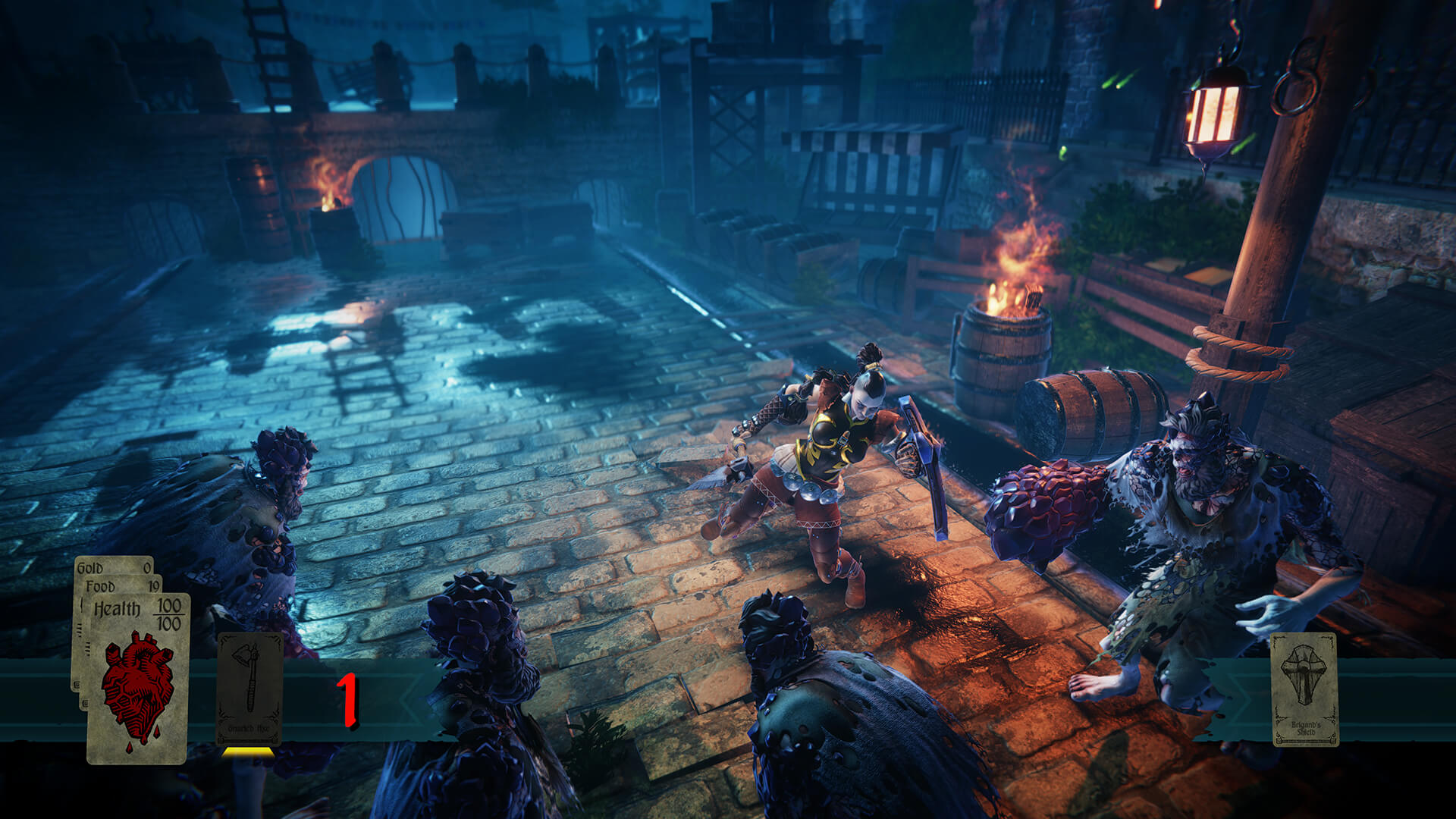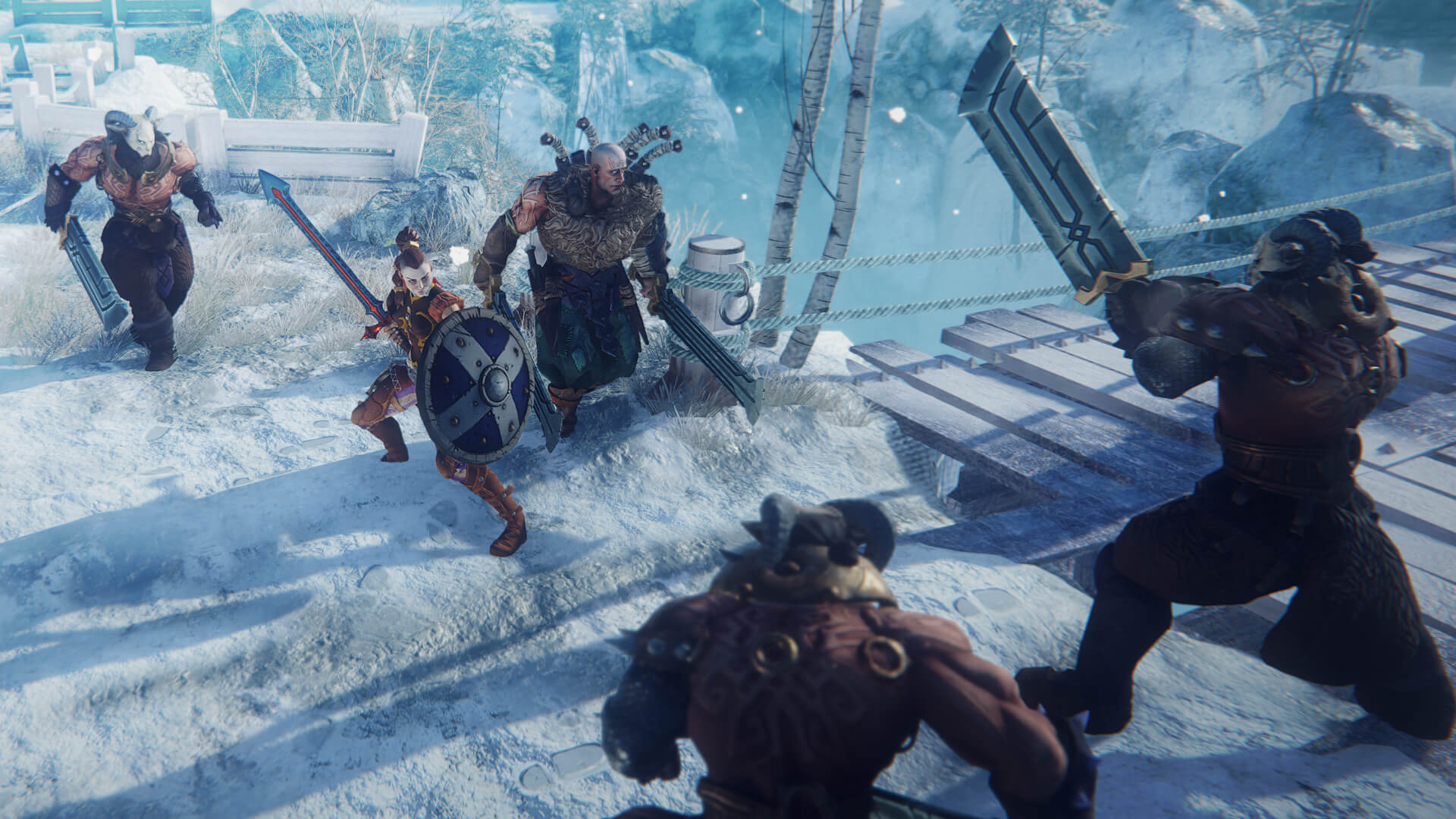Platforms:
Xbox One, PS4, PC
Released:
November 8, 2017
Publisher:
Defiant Development
Developer:
Defiant Development
You sit face to face with the dealer. Your fate firmly sealed within the grasp of his withered hands. A deck of cards reveals the long journey you took to get to the dealer’s side. Each card a blank moment of your history that needs to be written into existence. The game is new but the stakes remain the same: “Life, death, and vengeance.”
The dealer leans forward as his voice pierces the silence around you. “Make your first choice and let us set these wheels in motion once more.”
Hand of Fate 2 revisits the unique and captivating formula created in the original game. The game plays like a tabletop experience with your player token moving from one card to the next. Each step you take reveals the next chapter in your history and you have to be able to adapt on the fly and deal with whatever semi-randomised scenario pops up. Your journey is narrated by the dealer which Dungeons & Dragons fans will instantly recognise as the Dungeon Master for your game. The cards you reveal along your path will each require different actions and have different consequences, the most dramatic of which is an encounter card that will fling your character into a third person combat situation which plays like a Batman Arkham fight.
The idea behind the game is truly unique and impressive. A mixture of strategic deck building, Dungeons & Dragons (D&D), and third-person combat. Experiencing it for the first time back in 2016 at PAX Australia was quite a wondrous moment, and seeing the game iterate and advance in cool new ways brings a big smile to my face. Sweeping changes have been made in Hand of Fate 2 to essentially every aspect of the game, bringing new life to old systems and advancing the game in some pretty drastic ways.
“A game of life or death with a formidable and menacing dealer. Every line of dialogue or action is helping to set the scene and seal your fate.”
What is immediately noticeable to those who play Hand of Fate 2 is just how well the developers nail the atmosphere of the game. You’re playing a game of life or death with a formidable and menacing dealer. Every line of dialogue or action is helping to set the scene and seal your fate. The character of the dealer is phenomenal and every line of dialogue is not only fantastically scripted but is also voice acted to perfection. The dealer is mysterious, formidable and absolutely focused on his game – all of which is constantly reinforced by his words. As you play the game, the dealer will continue to talk, narrating your journey and painting a picture of what befalls your character. An impressive amount of dialogue has been recorded which triggers adaptively depending on the actions you take and the cards that reveal.
Defiant have really doubled down on the whole D&D aspect of Hands of Fate 2. Every card is a mini journey and you’ll have a lot more options when tackling certain situations. No longer are you simply moving along a nondescript path, you’re instead moving through the twisted streets of an infected city, a dark woods with almost limitless pathways and hidden bandits, or a whole slew of other unique scenarios. The cards you reveal fall into the world appropriately and have considerably more depth than anything from the original Hand of Fate.
As you reveal certain cards you will have the opportunity to obtain a token if you seized victory from the scenario laid out before you. You will also gain tokens for beating a deck. These tokens grant you more cards which range from new gear, new scenarios, starting bonuses and more. It is with these cards that the game’s deck building element comes in. Whilst some cards will be permanently found within particular decks, you get to fill out the rest of the deck with cards of your own choice. A smart deck builder will stack the deck with the best equipment they have found on their journey and with useful scenarios that have the potential to give great rewards. Of course you have to balance these old and faithful cards with new cards that have currently unknown properties and cards that have the potential to reward you with a new token so that you have more to work with for future decks.
Deck building in Hand of Fate 2 is great and yet another improvement over the first game. Those who don’t want to engage in it can allow the game to make your deck for you but I think these people are missing out on a seriously interesting tactical element.

The game has a whole range of different decks for you to complete, each creating a different scenario. Beating one will reveal more of the map and unlock new decks that eventually lead you to the dealer. You have a bit of freedom here to choose the decks you want to tackle as more than one is likely to be revealed after completing another. I would recommend playing each deck at least once because they can vary wildly. These decks / scenarios are actually my least favourite thing about the game, and for me they turned an otherwise brilliant experience into something rather tedious. Let me explain why.
“Hand of Fate 2’s scenarios felt like a bonus challenge rather than a main campaign.”
Hand of Fate 2’s scenarios felt like a bonus challenge rather than a main campaign. Each deck was a deviation to the standard formula where some extra element was added or some curve-ball was thrown your way that altered your play pattern fairly significantly. I didn’t like it. I begun craving the standard Hand of Fate formula. You know, the formula that the game’s design was meticulously balanced around.
Don’t get me wrong, some scenarios were fun, but they absolutely reached a point of tedium. Not to mention you were often at the whim of the RNG gods. A scenario called strength begun you one hit away from death. I remember playing this scenario time and time again, avoiding any damage like the plague, playing super cautiously, often getting quite far, but usually failing. After multiple tries I was finally graced by the RNG gods with some increased life after the first battle, making the rest of the scenario a cake walk. Another deck put you in an escort mission where your hapless companion would constantly get kidnapped and you’d need to chase him down, backtracking through previous areas. Needless to say this wasn’t the most fun mission available.
Unlike the original game, a successful run didn’t feel like a well balanced and impressive victory that I could be proud of. And adding a crazy multiplier such as requiring double the amount of food as your typical game doesn’t add to the strategy, it takes away from it. Deck building may be an improved mechanic but in many instances I found myself having to stack the deck with certain cards (food cards in this example) rather than creating a balanced or personalised approach.
Possibly the worst part about these unique scenarios is that they were often won or lost right at the end. The scenarios that required you to gather a certain amount of resource by the time you reach the end were so infuriating. The idea that you can play a 40+ minute game and feel as though you are doing everything right, only to reach the end and not have enough resources is awful. There’s no indication or way to know that you are failing. You could feel really great about how you’ve played but still be told you didn’t do good enough and there’s nothing tangible for you to look at, no glaring mistake you made, that would allow you to figure out why. Time to replay that whole scenario again, I guess.
What I did enjoy about the game was the increased variety to the games of chance. In Hand of Fate 1 the only game of chance was a shuffled deck which asks you to pick the success card. This minigame still remains but the game also spices things up with other minigames such as dice rolls, a swinging pendulum, or a wheel of fortune. Each is unique in its own way and cleverly toes the line between chance and skill.
Treasure rooms are also back which throw your character into a room full of treasure but also full of traps. Timing is key here and these areas make for a fun variation to the standard formula.

The other big aspect of the game we do need to talk about is combat. As previously mentioned, the game will occasionally throw you into a combat scenario that plays out like a Batman Arkham battle. You jump from one enemy to the next, build your combo metre, and reflexively parry, dodge, or stun your foes when an indicator pops up. Combat in the original game was a little bit rough and a bit too simplistic, but Defiant definitely put in some effort to make advancements in this field. The areas you battle are more varied and impressive and the enemies you face are certainly more diverse. You now have to focus a great deal more and respond to the enemies attacks in the right way. You also have a companion to help you fight and a few more tricks up your sleeve that make things more dynamic and interesting.
I don’t think combat is perfect yet though. The animation quality between a Batman game and Hand of Fate is pretty drastic. It’s totally understandable when you look at the budget of one game compared the other, but that doesn’t make the difference in quality any less noticeable. The real problem is when the game doesn’t properly respond to your outputs. Occasionally I found myself taking damage because the game didn’t stack up and execute my commands effectively or because an animation was slow to trigger. Also I found it a bit off-putting that the colour coded indicators that popped up over an enemies head didn’t match the colour of the button I needed to push on my Xbox 360 controller. This created initial confusion and certainly made me wonder why the game used colour coded indicators at all if those colours weren’t suppose to match up with anything. Maybe the the game didn’t know what controller I was using or was built for a different controller?
Positive:
- Amazing atmosphere and narration
- Fantastic world building and D&D elements
- Improved combat
- A unique and captivating mix of genres
Negative:
- Combat still has its downfalls
- Scenarios can be tedious and infuriating
An Australian developer creating a game of an exceptionally high quality is always something to celebrate. The original Hand of Fate will go down as one of my all time favourite Australian games ever developed and Hand of Fate 2 looked ready to raise that bar ever higher. The devs updated almost every aspect of the game, most of which for the better, but I just can’t get over how the game handles scenarios. It feels like such a fantastic product structurally speaking but I’d be lying if I didn’t say my enjoyment wasn’t heavily impacted by long and frustrating decks. Having said that, those who have not played either of the Hand of Fate games should pick this up, if only to experience the incredibly unique design and absolutely phenomenal atmosphere and narration.










